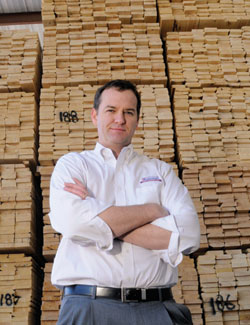Staying Ahead of the Game
If he were looking for money to buy a lumberyard today, John Jones knows that “the borrowing would have never happened.” But in mid 2007, when he needed cash to buy Douglas Lumber in Castle Rock, Colo., banks “were still willing to listen to a story, and we had a pretty interesting business plan.”
Jones is a former business and information technology consultant who decided one day that he didn’t much care for consulting, corporate politics, or all the travel. He and his wife had run a few small businesses in the past, including a retail shop in California. He had also done some building himself on previous projects, and thought he might find a “comfort level” in the retail building products industry.
“I knew just enough to be dangerous,” he laughs now. “I had a lot to learn.”
So when the couple moved to Denver in 2005 (she took a job with a locally based building products manufacturer), they made a list of criteria for the kind of business they wanted. It had to be an existing store (“personally, I’m better at taking something and fixing it than starting something new,” Jones admits), community based, and capable of selling green products. The couple also wanted to own the land it was on.
It took them 18 months, and a few failed deals (including a window and door shop they looked at), before Douglas Lumber came onto their radar screen. The yard’s owner had owned the company for a generation. He wanted to retire and had no succession plan in place. “At the time, he was just looking to sell the land, but the market was at a weird place, and there weren’t a lot of takers,” recalls Jones. Foxworth-Galbraith Lumber already had a store in Castle Rock, a town of 40,000 about 30 miles south of Denver. ProBuild serviced that market from a huge yard 18 miles away. And Lowe’s was about to open there.
Despite all that competition, Jones believed at the time that he’d be able to provide better service out of Douglas Lumber. He didn’t think Foxworth-Galbraith’s business model–a six-acre yard with a sparse staff that catered primarily to production builders–was a good fit for the area. (And he was proved right when Foxworth-Galbraith closed that yard six months later. Jones hired that yard’s inside sales manager.)
Douglas Lumber, on the other hand, serves mostly custom builders of between one and five homes per year each, as well as contractors, deck builders, remodelers, and barn builders. It generates about $2 million in annual sales, “and we do very well with special orders,” says Jones. The company has between 40 and 50 active accounts, or double the number it had before Jones took over. “We hope to be in a good position when business returns,” says Jones, who runs Douglas Lumber with six employees.
Willing Lenders. Jones’ total investment in Douglas Lumber exceeds $1 million, and his financing came from two sources. The yard’s owner wanted cash flow from the sale, so he was willing to finance the purchase of the land. And Jones cut his land costs in half by splitting them with a partner who currently operates an unrelated retail business on the premises. Jones operates his retail store out of a barn-like building that was only 25% to 30% utilized by the previous owner. (Jones completely rehabbed that building, which he paid for out of pocket.)
To purchase Douglas Lumber’s business assets, Jones negotiated a Small Business Administration loan through Wells Fargo. He praised that bank for doing “an incredible job to make our deal work.” Wells Fargo provided a 15-year loan at 1.5 points over prime, with six months of interest-only payments to help get the business on its feet. As the economy slackened, Wells Fargo was flexible on payment terms to help sustain Douglas Lumber’s cash flow.
But to lower his costs, Jones has since switched providers for his company’s payroll, merchant services, and operating credit cards, which Wells Fargo had been handling initially. Jones admits he’s also considered shifting his business to another commercial bank that has a better understanding of the building products business, even though there aren’t a lot of local banks rushing to take on new business with pro dealers.
“I’ve learned that you have to be proactive with everything, including the relationship with your bank,” he explains. “These are all choices that we are willing to make in order to make sure we are ready when the market comes back.”
–John Caulfield

